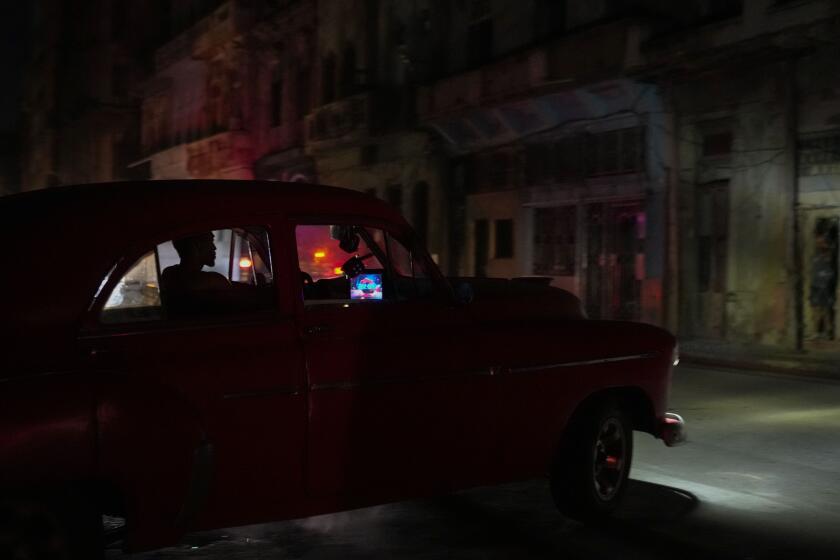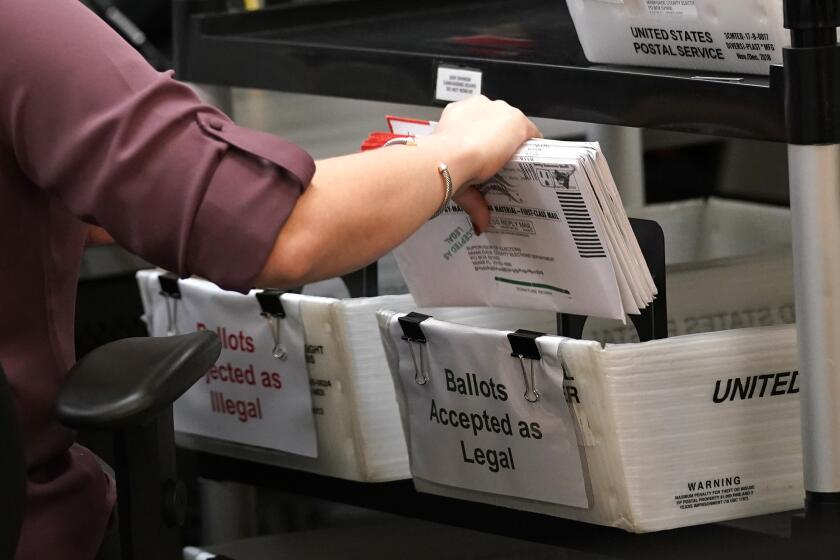Law and Science Vie in Hunt for Sea’s Treasures
When the gold-laden steamboat Central America sank 160 miles off the South Carolina coast in a hurricane in 1857, it seemed like a tragic ending to a tale of greed and hubris.
More than 400 men drowned, most of them prospectors dragged 8,000 feet to the Atlantic floor by the bounty they could not or would not let go of. The ship’s captain had known a storm was ahead, but he drove Central America smack through the middle of it anyway, thinking the steamboat’s state-of-the-art side-wheel would get the vessel safely through.
Today--at the dawn of a new era in shipwreck salvaging--science, technology and the law are clashing at the same spot where the Central America sank. And, like 130 years ago, pride in technology and human avarice are very much evident.
Modern Hunters
Armed with expensive, state-of-the-art sonar technology, assisted by scientists and financed by venture capitalists, treasure hunters are plying the oceans searching for--and discovering--wrecks like the Central America and the Titanic. And they are wasting no time in trying to recover artifacts from them.
These efforts are breaking new legal ground as the treasure-seekers wrangle with one another over rights to the wrecks. And they are provoking confrontation with archeologists, who are at once thrilled by the prospects of gaining new insights into historic cultures and frightened by the specter that relics will be lost in the salvaging process.
“Interest in shipwrecks has never been higher,” said Ross Holland, president of the National Foundation for Maritime Conservation.
Such interest has been sparked by the estimated $400 million worth of gold, jewels, and artifacts that treasure hunter Mel Fisher has recovered since 1985 from the Spanish galleon Atocha off the Florida keys, Holland said.
Technological Advances
But mainly the interest has been fueled by recent advances in technology that have allowed treasure hunters to venture much farther from shore to find wrecks that could not have been located previously.
The hunters are using powerful computers with tailor-made programs to correlate historical data--such as sailing times, wind speeds and ocean currents--to predict the most likely sites where a ship sank. The tools also include new sonar devices capable of searching three-mile-wide swaths of the ocean floor at one pass, compared to only several hundred feet just a few years ago.
Other computers are processing information from the sonar to produce vivid, easily decipherable pictures of the sea bottom.
And once a wreck is found, sophisticated remote-control devices are deployed to probe and explore the vessel, often bringing back startling images--and rich booty.
Many of these threads come together in the search for the Central America, which treasure hunter Thomas Thompson calls “one of the greatest shipwrecks we’ve had, prior to the Titanic.”
The 272-foot, wooden-hulled Central America was making her 44th round trip between Aspinwall (now Colon), Panama, and New York.
The completion of the Panama Railroad in 1855 had completed a vital link in the combined land and sea route between California and the East and the arduous voyage by clipper ship around South America’s Cape Horn was fast losing its appeal.
Gold Coins
On its final voyage, Central America was carrying 478 passengers, plus another 103 crew members. It also was carrying the monthly shipment of gold coins from the San Francisco Mint to banks in the East--gold that was worth more than $1.2 million in its day.
After it entered the hurricane, the Central America began taking on water. That extinguished the fire in its steam engines and stilled the bilge pumps that had prevented the ship from flooding.
For 30 hours, passengers and crew bailed with buckets, and that provided enough time for all 31 women and 29 children aboard, as well as 39 male passengers, to be evacuated to a nearby sailing vessel.
But because of the tremendous weight of the huge, now useless engines, the vessel sank shortly after dark on Sept. 12. Only 54 more men were subsequently picked up by passing ships.
Thompson, 35, is an ocean engineer who spent four years as chief engineer aboard two research vessels before he joined the Columbus-based Battelle Memorial Institute in 1980.
Battelle is a large research institute that conducts studies for government and industry on contract. There, Thompson conducted feasibility studies for deep-ocean mining of metals.
In that capacity, he began doing consulting work for shipwreck recovery firms on the East Coast. “I got a feel for what shipwreck search and recovery is all about,” Thompson recalled during a telephone interview from Wilmington, N.C., where he was re-provisioning his salvage vessel, the Nicor Navigator.
“I got interested in deep-water wrecks like the Central America because they were less likely to have been disturbed by other salvors,” he said. “But there was no way to do this then.”
Side-Wheel Drive
Thompson was particularly interested in the Central America because of its unique side-wheel architecture. “They were only made for about 30 years and only nine sank. So if we find something that looks like this, we have a good idea of what it is.”
By July 1985, he was convinced that search technology had ripened. Taking a leave of absence from Battelle, Thompson formed Columbus-America Discovery Group, and raised $5 million from local investors for his search.
Operating out of a large Victorian house in his native Columbus, he assembled a staff of 11 historians and researchers to gather everything known about the Central America and the circumstances surrounding its sinking.
The data then was correlated in a computer relying on techniques first used to find an H-bomb that fell harmlessly into the Mediterranean in 1966 when a B-52 bomber and a KC-135 tanker collided.
The computer narrowed the search to a 1,400-square-mile area on what is called the Blake Ridge, 150 miles off the South Carolina coast.
“The ridge is virtually ideal for sonar searching because it is flat and featureless, and anything like a ship will show up clearly,” Thompson said.
But the most useful tool of all came with the new adaptations in the use of side-scan sonars.
In the side-scan sonar, a “fish” towed behind a search ship emits a narrow band of sound waves toward the ocean floor. Sensitive microphones pick up the echoes that bounce off the objects or the sea floor, and computers use the elapsed time for each echo to calculate the distance to that point.
Manganese Search
Side-scan sonar was developed in the 1970s to help find manganese nodules on the ocean floor; recovery of those nodules did not prove economically feasible, however.
During the 1980s, companies like International Submarine Technology of Seattle refined the technology to give much better pictures of the ocean floor. In particular, the company improved it so that the device could cover a swath 15,000 feet wide rather than the several hundred feet covered by earlier models.
The sonar units cost anywhere from $300,000 to $1.5 million. “But what we were interested in was a reduction of risk rather than a reduction of cost,” Thompson said. The actual search for the Central America last summer took 40 days.
In 1985, the search for the Titanic also had taken about 40 days. But that search covered only 140 square miles--less than a tenth of the area searched by Thompson. About 80% of the Titanic search was performed with less sophisticated side-scan sonar owned by the Paris-based oceanographic research institute IFREMER. The ship was actually located during a search with television cameras by Robert Ballard of the Woods Hole Oceanographic Institution in Massachusetts.
During the search for Central America, Thompson said, the hunters found about 400 “anomalies,” nine of which were later found to be wrecks. Most of the rest were 55-gallon drums that probably were discarded from ships.
The group kept its discoveries secret and went back in May to resume surveying the site. But it was forced to go public when a second group of searchers appeared on the horizon.
The second team was financed by a group of investors called Boston Salvage Consultants Inc. A partner in the group, Boston investment banker John O’Brian, refused to discuss the details of the operation, but said that his group’s financial resources were “at least as great” as those of Columbus-America.
Experts Hired
The Boston group has hired the services of treasure hunter Burt Webber, who in 1979 found the Spanish galleon Concepcion in a coral reef 85 miles north of the Dominican Republic. Webber in turn hired William Ryan of Columbia University’s Lamont-Doherty Geological Observatory in New York City. Ryan, who had searched unsuccessfully for the Titanic, has sonar apparatus similar to that used by Thompson.
A third group, three businessmen from Georgetown, S.C., incorporated as the South Carolina Marine Archaeological Trust, have hired Steadfast Engineering of Norfolk, Va., to find the Central America. Steadfast frequently has been hired to locate the remains of plane crashes in the ocean. That expedition has not left port yet.
Alarmed by the latecomers, Thompson’s group quickly recovered wood, coal, and metal samples from the debris field surrounding what they believe to be the Central America and took them to the U.S. District Court in Norfolk.
On July 16, Judge Richard B. Kellam appointed Columbus-America custodian of the wreck and issued an injunction barring all others from entering a 15-square-mile area around the wreck.
Kellam claimed jurisdiction over the wreck, even though it is outside U.S. territorial waters, because the vessel was an American ship, because the discovering group was American and, most important, because the first salvaged remains were taken to an American port, according to Norfolk attorney Richard T. Robol, who represented Columbus-America.
Kellam’s ruling was “unprecedented--a novel exercise of admiralty jurisdiction,” said San Francisco maritime law expert Graydon Staring, who was not involved in the case. Boston Salvage appealed, claiming that Kellam did not have jurisdiction, but on Aug. 3 the U.S. 4th Circuit Court of Appeals refused to stay the injunction while the appeal is pending.
Kellam’s was the second critical legal decision this year affecting treasure hunters. In May, a Massachusetts Superior Court ruled that the “finders keepers” federal admiralty laws have precedence over the rights of individual states and that the states cannot confiscate a share of booty from wrecks within the three-mile territorial limit.
Stimulation of Others
Both decisions should have the effect of further stimulating treasure hunting because they increase the likelihood that a treasure seeker can retain salvage rights, maritime lawyers said.
Meanwhile, Thompson’s group is continuing to survey the Central America site, producing stereo pictures, videotapes, and photomosaics. They are also collecting artifacts “in small amounts” from the debris field. This work is accomplished with specially designed work equipment that is suspended from the surface, unlike the manned submersible Alvin used to explore the Titanic.
Because the equipment is suspended, it does not require vertical thrusters--”so you don’t take a risk of destroying artifacts and the visibility is much better,” Thompson said. “And because it is operated from the surface, it can work 24 hours a day.”
Columbus-America plans to begin next year to construct other equipment on the 1.5-mile-deep sea floor, including industrial-type robots, to carry out the salvage operation, Thompson said.
But for now, they are just trying to learn as much about the site as they can before the weather begins to turn bad at the end of August. “It’s very important to understand the site before we start digging it up and losing information.”
But scientists fear they will lose information anyway because there are no archeologists involved in the operation. “Once you remove artifacts from their context, their scientific value is destroyed,” said marine archeologist Barto Arnold of the Texas Antiquities Commission in Austin. “It’s the relative location that tells the story.”
Some scientists fear a repetition of the events that occurred during the salvage of the DeBraak in August, 1986, which underwater archeologist Allen Albright of the South Carolina Institute of Archaeology in Columbia, S.C., calls “a horror case.” Salvors hired by New Hampshire developer L. John Davidson had tried to raise the 18th-Century British warship from the Delaware Bay before the the artifacts were removed. During that process, the ship tilted and everything in it was dumped onto the bottom, where much of it was lost.
Two Called Incompatible
“Commercial treasure salvage is just not compatible with archeology,” Arnold said.
The shipwreck finders, of course, do not consider themselves looters. “We have a responsibility to preserve the history and the culture and those things that have to do with the shipwreck itself,” said Thompson, who argues that his group is doing a good job documenting the Central America site.
Ballard has argued that no artifacts should be removed from the Titanic. But IFREMER in July retrieved dishes from the Titanic and it said it intends to display them .
Because of such conflicts, many archeologists favor a bill introduced by Rep. Charles E. Bennett (D-Fla.) that would create a protective “historic site” designation around wrecks that would be analogous to that used for land sites. The bill would also return control of ships in territorial waters to individual states.
The bill was approved Wednesday by the oceanography subcommittee of the House Merchant Marine and Fisheries Committee. But Committee Chairman Walter B. Jones (D-N.C.) has indicated that the panel would not consider it until the Senate takes action on a similar bill.
“All of us are interested in saving historical vessels of interest to the American public,” said marine archeologist John Broadwater of the Virginia Department of Conservation and Historic Resources in Yorktown. “We’re fervently hoping it will eventually get resolved.”
More to Read
Sign up for Essential California
The most important California stories and recommendations in your inbox every morning.
You may occasionally receive promotional content from the Los Angeles Times.










